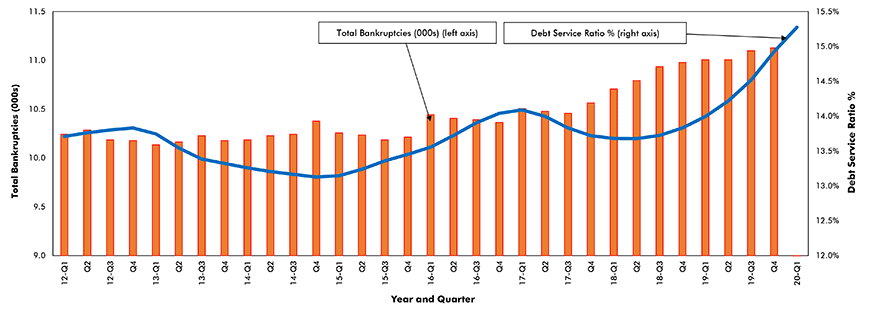“Prediction” as the Danish Nobel Prize-winning physicist Niels Bohr once said, “is very difficult, especially about the future”. This statement is particularly applicable to any attempt to gauge both the current and the future health of Canada’s housing market, which is obscured by a virtually impenetrable cloud of uncertainty. Having said this, there are several key variables that will significantly impact both housing demand and supply in the country in the near term.
Before looking forward, it is worth taking a quick look at what happened in the recent past. First, despite being dragged down by COVID-19 in late March, the volume of homes sold in the first quarter was up by 15% y/y, their largest first-quarter year over year gain since 2016. Driven by this stronger demand, the average house price in the country rose by 13.1% y/y while new listings declined by -4.4%. On the supply side, seasonally adjusted housing starts averaged 194,000 units in the first quarter, up from 172,000 in Q1/2019. This 12% y/y rise was largely due to strength in starts of singles and semi-detached units.
With home sales in several major cities including Toronto, Vancouver, and Calgary down by an estimated 10% to 30% in the last two weeks of March and by 61% y/y in the month April, it is likely that the layoffs — due to the shutdown of all non-essential business activity, plus the curtailment of open houses, — will cause home sales in the country to drop by 60% to 70% y/y in April. Given the likelihood that most provinces will be extending their lockdowns through May and possibly into June, we expect home sales to remain depressed into July. Would-be sellers were also sidelined in April due to COVID-19. Given the impediments to new residential construction and the fact that residential construction in the province of Quebec was suspended in April, we expect housing starts in the second quarter to retreat to 75,000 to 125,000 units annualized down from 207,000 in the first quarter.
Looking forward, the outlook for home sales and new residential construction is critically dependent on the timing of the re-opening of the economy and the rehiring of the estimated 2.5 million individuals who have lost their jobs since February. The longer political leaders postpone opening the economy, the greater the risk that a “V” shaped recovery becomes an extended “U” shaped one, or that we experience a protracted period of economic stagnation. Just as ambulation (i.e., getting a patient up and walking) is critical to their recovery after major surgery, getting the economy up and running is vital to avoid moving into a situation of debt deflation. This occurs when household incomes drop, but the value of their debts doesn’t. Consumers, unable to get their financial heads back above water, contribute to a persisting drag on spending and residential construction.
Two indicators highlight how consumers in Canada are significantly more at risk of being drowned in debt than they have been for several years. First, fueled by low interest rates and strong employment growth, consumer and mortgage borrowing has risen by 3.6% y/y while disposable incomes are up on average by 4.4%. Despite this stronger pattern of income growth, over the past year, the total debt service ratio (i.e., the percentage of income spent paying interest and principal) has increased from 14.8% to 15.0%, its highest level in more than twenty years. Consistent with this increase in debt service costs, the number of consumer insolvencies in Canada averaged 11,599 over the twelve months ending February of this year. This was their highest average in more than 7 years.
While the recently announced federal income support programs will provide a temporary financial life jacket to the millions who have been laid off due to COVID-19, they are temporary and cannot last forever. Moreover, financial institutions have committed to defer, not to cancel, up to six monthly mortgage payments. Once the homeowner is re-employed, he or she will face an increased debt burden and higher carrying costs.
This increased drag on spending due to potentially higher debt payments means more millennials (who make up the largest percentage of first-time home buyers) will be forced to borrow or dip into their savings, seriously threatening the outlook for housing demand in the second half of the year.
John Clinkard has over 35 years’ experience as an economist in international, national and regional research and analysis with leading financial institutions and media outlets in Canada.
Total Bankruptcies vs Household Debt Service Ratio*

Chart: ConstructConnect — CanaData.











Recent Comments
comments for this post are closed